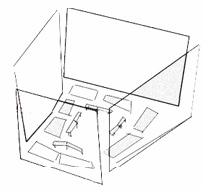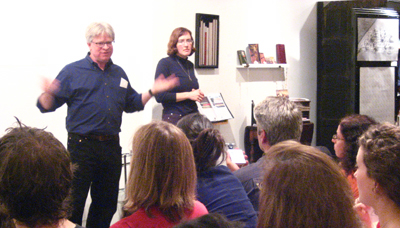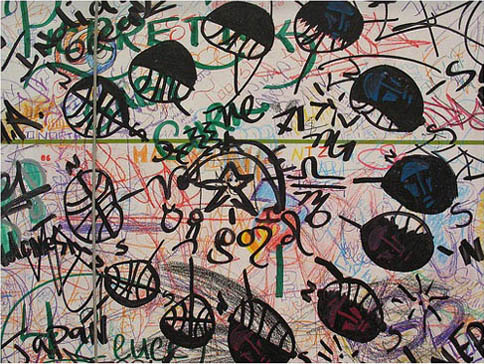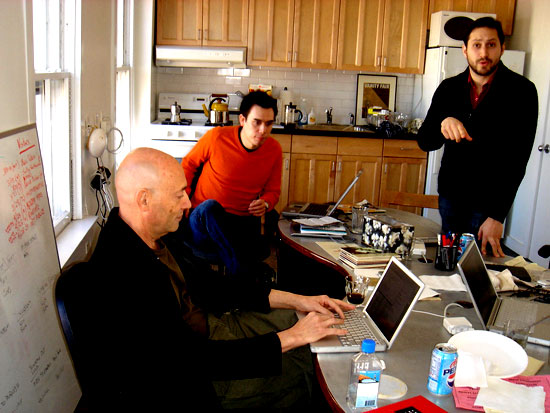 Monkeybook is an occasional series of new media evenings hosted by the Institute for the Future of the Book at Monkey Town, Brooklyn’s premier video salon and A/V sandbox.
Monkeybook is an occasional series of new media evenings hosted by the Institute for the Future of the Book at Monkey Town, Brooklyn’s premier video salon and A/V sandbox.
Monkeybook 3 (this coming Monday, Aug 27, reservation info below) is presented jointly with the Desk Set, a delightful network of young New York librarians, archivists and weird book people that periodically gets sloshed in northern Brooklyn. (If this rings a bell, it may be because you read about them in the Times last month – ?somehow this became one of the “most emailed” NYT articles of recent months).
I first collided with the Desk Set at a talk I gave at Brooklyn College this June. We resolved to get together later in the summer and eventually this crazy event materialized. The crowd will be primarily librarians and folks from the Desk Set community. Dan and I will be masters of ceremonies, presenting the Institute’s projects and then spinning an eclectic assortment of films and other goodies (including some stuff by Alex Itin, who was the star of Monkeybook 1). It’ll basically be a big librarian party. How can you resist?
Oh, and how cool: we’re an editors’ pick on Going.com!
Monkey Town reservations: http://www.monkeytownhq.com/reservations.html (book soon, it’s already pretty packed!)
Monkey Town: 58 N. 3rd St. (between Wythe and Kent), Williamsburg, Brooklyn
View Larger Map
Category Archives: brooklyn
talk at brooklyn college library
If you’re in the New York area, this Wednesday I’ll be giving a talk at an event organized by the Brooklyn College Library called “It’s All About the Book.” Also speaking will be Jason Epstein, one of the all-time great innovators in print publishing, and founder most recently of On Demand Books. Talks will be followed by a tour of “books as art” installations by a number of local artists, curators and librarians. It promises to be an interesting event, well worth the trek to Flatbush.
the year-long Interdisciplinary Library Exhibit launches
 The year-long Interdisciplinary Library Exhibit started last night at Proteus Gowanus, an arts organization located in Brooklyn, New York. The opening event was a standing room only presentation by Rick Prelinger and Megan Shaw Prelinger who run the Prelinger Library. Their presentation focused on their work leading up to the creation of the library, a highly curated collection of printed matter they have accumulated over two decades. The collection has a strong focus on books, print ephemera and periodicals. The 40,000 plus items are now on display and open to the public in downtown San Francisco. Visitors are allowed to stop in and browse items from the collection. The library’s collection is an amazing experiment in curation, taxonomy (they created their own,) and commentary on how libraries are shifting forms. We were fortunate to have lunch with Rick and Megan before their event. Everyone at the institute found their work very inspiring and they will be discussed in more detail in upcoming posts.
The year-long Interdisciplinary Library Exhibit started last night at Proteus Gowanus, an arts organization located in Brooklyn, New York. The opening event was a standing room only presentation by Rick Prelinger and Megan Shaw Prelinger who run the Prelinger Library. Their presentation focused on their work leading up to the creation of the library, a highly curated collection of printed matter they have accumulated over two decades. The collection has a strong focus on books, print ephemera and periodicals. The 40,000 plus items are now on display and open to the public in downtown San Francisco. Visitors are allowed to stop in and browse items from the collection. The library’s collection is an amazing experiment in curation, taxonomy (they created their own,) and commentary on how libraries are shifting forms. We were fortunate to have lunch with Rick and Megan before their event. Everyone at the institute found their work very inspiring and they will be discussed in more detail in upcoming posts.
The spirit of the Prelinger’s work is great introduction to Proteus Gowanus’ exploration on this theme. Libraries are in flux, as they have historically played many roles, including distributors of knowledge, places that support research, archives and now quite often, community centers. For the next year, Proteus Gowans is displaying in their gallery, artwork related to libraries as well as hosting presentations and films. Photos by Nina Katchadourian depict the spines of various books which compose textual messages. Artist Jeffrey Schiff’s contribution plays with the Dewey Decimal System and themes of categorizations by applying call numbers to everyday objects and spaces. Also, included in the exhibit is the Reanimation Library, curated and owned by Andrew Beccone. This collection preserves books that are not typically saved in public and academic libraries, including titles such as “Simplified Taxidermy,” “A Guide to Gymnastics” and “Judo: Thirty Lessons in the Modern Science of Jiu-Jitsu.” The next event is Deirdre Lawrence, the Principal Librarian and Coordinator of Research Services Museum Libraries and Archives at the Brooklyn Museum, on October 27th.
Issues of funding, the rise of the digital, and intellectual property are all changing the role of libraries and how people interact with them. Many large questions are being asked about the future of the library. The most basic one being, what will it look like? Will it start to shift towards smaller nodes of semi-private collections connected to each other via the network? Are collections of books going to be increasingly less tied to physical spaces? Will the public library continue to shift towards acting more like a community center? Are publishers and libraries going fuse and produce a new hybrid institution?
Realizing that libraries are going through a cultural as well as technological transformation, Proteus Gowanus is embarking on an year long examination in a variety of media which track these changes. They may not be able to answer any of these questions directly, but they are certainly providing new directions and understandings. Most importantly, the Interdisciplinary Library Exhibit is opening up the conversation to a diversity of voices, including the public at large.
flickr as virtual museum

A local story. The Brooklyn Museum has been availing itself of various services at Flickr in conjunction with its new “Grafitti” exhibit, assembling photo sets and creating a group photo pool. In addition, the museum welcomes anyone to contribute photographs of grafitti from around Brooklyn to be incorporated into the main photo stream, along with images of a growing public grafitti mural on-site at the museum where visitors can pick up a colored pencil and start scribbling away. Here’s a picture from the first week of the mural:

This is an interesting case of a major cultural institution nurturing an outer curatorial ring to complement, and even inform, a central exhibit (the Institute conducted a similar experiment around Christo’s Gates installation in Central Park, 2005). It’s especially well suited to a show about grafitti, which is already a popular subject of amateur street photography. The museum has cleverly enlisted the collective eyes of the community to cover a terrain (a good chunk of the total surface area of Brooklyn) far too vast for any single organization to fully survey. (The quip has no doubt already been made that users be sure not forget to tag their photos.)
Thanks, Alex, for pointing this out.
the age of amphibians
 Momus is a Scottish pop musician, based in Berlin, who writes smart and original things about art and technology. He blogs a wonderful blog called Click Opera — some of the best reading on the web. He wears an eye patch. And he is currently doing a stint as an “unreliable tour guide” at the Whitney Biennial, roving through the galleries, sneaking up behind museum-goers with a bullhorn.
Momus is a Scottish pop musician, based in Berlin, who writes smart and original things about art and technology. He blogs a wonderful blog called Click Opera — some of the best reading on the web. He wears an eye patch. And he is currently doing a stint as an “unreliable tour guide” at the Whitney Biennial, roving through the galleries, sneaking up behind museum-goers with a bullhorn.
A couple of weeks ago, Dan had the bright idea of inviting Momus — seeing as he is currently captive in New York and interested, like us, in the human migration from analog to digital — to visit the institute. Knowing almost nothing about who we are or what we do, he bravely accepted the offer and came over to Brooklyn on one of the Whitney’s dark days and lunched at our table on the customary menu of falafel and babaganoush. Yesterday, he blogged some thoughts about our meeting.
Early on, as happens with most guests, Momus asked something along the lines of: “so what do you mean by ‘future of the book?'” Always an interesting moment, in a generally blue-sky, thinky endeavor such as ours, when you’re forced to pin down some specifics (though in other areas, like Sophie, it’s all about specifics). “Well,” (some clearing of throats) “what we mean is…” “Well, you see, the thing you have to understand is…” …and once again we launch into a conversation that seems to lap at the edges of our table with tide-like regularity. Overheard:
“Well, we don’t mean books in the literal sense…”
“The book at its most essential: an instrument for moving big ideas.”
“A sustained chunk of thought.”
And so it goes… In the end, though, it seems that Momus figured out what we were up to, picking up on our obsession with the relationship between books and conversation:
It seems they’re assuming that the book itself is already over, and that it will survive now as a metaphor for intelligent conversation in networks.
It’s always interesting (and helpful) to hear our operation described by an outside observer. Momus grasped (though I don’t think totally agreed with) how the idea of “the book” might be a useful tool for posing some big questions about where we’re headed — a metaphorical vessel for charting a sea of unknowns. And yet also a concrete form that is being reinvented.
Another choice tidbit from Momus’ report — the hapless traveler’s first encounter with the institute:
I found myself in a kitchen overlooking the sandy back courtyard of a plain clapperboard building on North 7th Street. There were about six men sitting around a kidney-shaped table. One of them was older than the others and looked like a delicate Vulcan. “I expect you’re wondering why you’re here?” he said. “Yes, I’ve been very trusting,” I replied, wondering if I was about to be held hostage by a resistance movement of some kind.
Well, it turned out that the Vulcan was none other than Bob Stein, who founded the amazing Voyager multi-media company, the reference for intelligent CD-ROM publishing in the 90s.
He took this lovely picture of the office:

Interestingly, Momus splices his thoughts on us with some musings on “blooks” (books that began as blogs), commenting on the recently announced winners of lulu.com‘s annual Blooker Prize:
What is a blook? It’s a blog that turns into a book, the way, in evolution, mammals went back into the sea and became fish again. Except they didn’t really do that, although undoubtedly some of us still enjoy a good swim.
And expanding upon this in a comment further down:
…the cunning thing about the concept of the blook is that it posits the book as coming after the blog, not before it, as some evolutionist of media forms would probably do. In this reading, blogs are the past of the book, not its future.
To be that evolutionist for a moment, the “blook” is indeed a curious species, falling somewhere under the genus “networked book,” but at the same time resisting cozy classification, wriggling off the taxonomic hook by virtue of its seemingly regressive character: moving from bits back to atoms; live continuous feedback back to inert bindings and glue. I suspect that “the blook” will be looked back upon as an intriguing artifact of a transitional period, a time when the great apes began sprouting gills.
If we are in fact becoming “post-book,” might this be a regression? A return to an aquatic state of culture, free-flowing and gradually accreting like oral tradition, away from the solid land of paper, print and books? Are we living, then, in an age of amphibians? Hopping in and out of the water, equally at home in both? Is the blog that tentative dip in the water and the blook the return to terra firma?

But I thought the theory of evolution had broken free of this kind of directionality: the Enlightenment idea of progress, the great chain gang of being. Isn’t it all just a long meander, full of forks, leaps and mutations? And so isn’t the future of the book also its past? Might we move beyond the book and yet also stay with it, whether as some defined form or an actual thing in our (webbed) hands? No progress, no regress, just one long continuous motion? Sounds sort of like a conversation…
hacking nature

Slate is trying something new with its art criticism: a new “gallery” feature where each month an important artist will be discussed alongside a rich media presentation of their work.
…we’re hoping to emphasize exciting new video and digital art–the kind of art that is hard to reproduce in print magazines.
For their first subject, they don’t push the print envelope terribly far (just a simple slideshow), but they do draw attention to some stunning work by Canadian photographer Edward Burtynsky, who (happily for us New Yorkers) has shows coming this week to the Brooklyn Museum and the Charles Cowles Gallery in Manhattan. Burtynsky documents landscapes bearing the mark of extreme human exploitation – the infernal streams flowing from nickel mines, junked ocean liners rusting in chunks on the beach, abandoned quarries ripe with algae in their cubic trenches, and an arresting series from recent travels through China’s industrial belt.
These photographs carry startling information through the image-surplussed web. But Burtynsky disappoints in one vital, perhaps deciding, respect:
…his position on the moral and political implications of his work is studiously neutral. He doesn’t point fingers or call for change; instead, he accepts industry’s exploitation of the land as the inevitable result of modern progress. “We have extracted from the land from the moment we stood on two feet,” he said in an interview in the exhibition catalog. “The entire 20th century has been a revving up of this large consumptive engine. It’s not a question of whether we are going to stop consuming. It’s not going to happen…”
As someone who believes that struggling to prevent (or at least mitigate) global ecological disaster should be the transcending narrative of our times, I find Burtynsky’s detachment deeply depressing and self-defeating. His images glory in the sick beauty of these ravaged scenes, and the cultural consumers that will no doubt pay large sums for these photographs at his upcoming Chelsea show only compound the cynicism.
